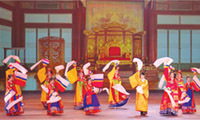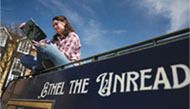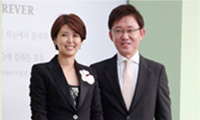The Ideals of Beauty, in the Eye of a Computer
For centuries, philosophers and scientists have tried to define a universal ideal of beauty. Now a computerized “beautification engine” uses a mathematical formula to alter a person’s photograph into a theoretically more attractive version, while maintaining what the programmers call an “unmistakable similarity” to the original.
The program, developed by computer scientists in Israel, is based on the responses of 68 men and women, age 25 to 40, from Israel and Germany, who viewed photographs of white male and female faces and picked the most attractive ones.
Scientists took the data and applied an algorithm involving 234 measurements between facial features, including the distances between lips and chin, the forehead and the eyes, or between the eyes. Essentially, they trained a computer to determine, for each individual face, the most attractive set of distances and then choose the ideal closest to the original face.
They ran the photographs of 92 women and 33 men through the engine, creating before and after shots. Changes were made only to the geometry of the faces; unlike the digital retouching done for fashion magazines, wrinkles were not smoothed and hair color was not changed.
The research, published in the August proceedings of Siggraph, an annual conference on computer graphics, is one of the latest studies in a growing field that merges beauty and science.
Studies have found there is surprising agreement about what makes a face attractive. Symmetry is at the core, along with youthfulness and clarity or smoothness of skin. There is little dissent across cultures, ethnicities, races, ages and genders.
Yet, like other attempts to use objective principles to define beauty, this computer program raises complex questions about the perception of beauty and a beauty ideal.
To what extent is beauty quantifiable- Does a supposedly scientific definition merely reflect the ideal of the moment, built from the images of pop culture and the news media?
“How can they prove it-” said Lois W. Banner, a historian who has studied changing beauty standards, referring to scientific efforts to define attractiveness. “They are never going to locate it on a gene. They are never going to get away from the cultural influence.”
Tommer Leyvand, who developed the software with three others at Tel Aviv University and who works for Microsoft in Redmond, Washington, said the goal was not to argue that the altered faces are more beautiful than the originals. Instead, he said, it was to tackle the challenge of altering a face according to agreed-upon standards of attractiveness, while producing a result that left the face completely recognizable, rather than the product of cosmetic surgery or digital retouching.
He suggested there were practical applications for his software, including advertisements, films and animation. He also said he had heard from plastic surgeons interested in the software.
While several psychological studies suggest that perceptions of beauty and attractiveness tend to be universal, critics of that work say it is debatable whether a person’s beauty is actually enhanced by such changes. Character can be lost. The quirky may become plain.
When Mr. Leyvand put a photograph of Brigitte Bardot through his program, her full and puckered lips were deflated, and the world-famous beauty seemed less striking - less like herself. By contrast, the before and after shots of the actor James Franco were almost indistinguishable, suggesting his classically handsome face is already pretty perfect.
Martina Eckstut, 25, an account executive for Kay Unger New York/Phoebe Couture, volunteered to be photographed and have her image beautified by the program. She said she was struck by how different she looked in the second shot.
“I think the after picture looks great, but it doesn’t really look like me at all,” she said in an e-mail message. “My entire bone structure, face shape and eye size is different, and my lip color looks changed as well.”
She added, “I would like to keep my original face.”
After viewing the before and after photographs of anonymous subjects in Mr. Leyvand’s research paper, Dr. Banner, who is a professor of history at the University of Southern California, said the original faces were more attractive. “Irregular beauty is the real beauty,” she said.
스마터리빙
more [ 건강]
[ 건강]이제 혈관 건강도 챙기자!
[현대해운]우리 눈에 보이지 않기 때문에 혈관 건강을 챙기는 것은 결코 쉽지 않은데요. 여러분은 혈관 건강을 유지하기 위해 어떤 노력을 하시나요?
 [ 건강]
[ 건강]내 몸이 건강해지는 과일궁합
 [ 라이프]
[ 라이프]벌레야 물럿거라! 천연 해충제 만들기
 [ 건강]
[ 건강]혈압 낮추는데 좋은 식품
[현대해운]혈관 건강은 주로 노화가 진행되면서 지켜야 할 문제라고 인식되어 왔습니다. 최근 생활 패턴과 식생활의 변화로 혈관의 노화 진행이 빨라지고
사람·사람들
more
[‘파친코’ 이민진 작가,인터뷰] “이민자와 취약계층 보호해야”
재미 한인 작가 이민진(57)씨가 새해 1월1일 뉴욕시장으로 취임하는 조란 맘다니(34) 뉴욕시장 당선인에 대해 “맘다니 시장이 긍정적인 변화…

김응화무용단, LA 카운티 연말축제서 ‘화관무’
김응화무용단이 지난 24일 열린 LA 카운티 연말 문화행사 제66회‘할러데이 축제’ 무대에 초청돼 한국 전통무용 ‘화관무’를 선보였다고 밝혔다…
이민단속·산불 영향 LA카운티 인구 감소
LA 카운티 인구가 올해 상당수 감소한 것으로 나타났다. 캘리포니아 주 재무국이 최근 발표한 자료에 따르면 올해 7월1일 기준 LA카운티의 인…
한인 2세, 드라마 ‘런’ 주연 맡아
권호열 세계무술총연맹 총재의 아들 에릭 권씨가 주연하는 드라마 ‘런(RUN)’ 시사회가 지난주 버지니아 애쉬번 소재 리걸 폭스 극장에서 열렸다…
[송년 행사] 코윈 퍼시픽 LA
한민족 여성네트워크(KOWIN) 퍼시픽 LA(회장 조미순)는 23일 LA 용수산에서 2025년 송년회를 열었다. 이날 행사에는 가정폭력 피해 …
많이 본 기사
- 러 “합의 근접했다는 트럼프에 동의…우크라, 돈바스 철군해야”
- “中, 대만 포위 좁히고 바로 실탄훈련…美 등 외부개입 억제신호”
- “트럼프-머스크 화해 중재자는 차기 대권 유력주자 밴스”
- 국방부, 여인형·이진우·고현석 ‘파면’…곽종근은 ‘해임’
- 백악관 “트럼프, 푸틴과 우크라 관련 긍정적 통화”
- ‘3특검 끝’ 법정다툼 본격화…尹부부 11개 재판 결론은
- [새해 달라지는 교통법규] 과속·음주운전 처벌 가주서 대폭 강화
- 영주권자도 생체정보 전면 확인 1
- 트럼프, 휴일 취재진에 식사 권하며 “뇌물로 여길건가”
- 트럼프, 베네수엘라 마약시설 타격 시사…첫 육상 공격 가능성
- ICE 단속 전략 전환… ‘현장 체포’ 급증
- 공화·민주, 내년 중간선거 앞두고 일제히 ‘이대남’ 구애
- 건강한 노년을 위한 식사법, 무엇을 어떻게 먹어야 할까
- 샤핑시 환불 정책 꼼꼼히 살펴야
- 신년 연휴에 또 비 이번주 ‘강풍주의보’
- 젤렌스키 “美, 15년간 안전보장 제안…최대 50년 원해”
- 中 “美, 대만에 무기 팔면 스스로를 해칠 것…70년전 중국 아냐”
- 트럼프 정부, 이민 2세대까지 공격
- 워싱턴 일원‘슈퍼 독감’비상
- “뉴욕주 ‘그린라이트 법’위헌 아니다“
- 다크 초콜릿·커피 속 ‘테오브로민’… “세포 노화 늦춘다”
- 이민자 트럭 운전사들 “면허박탈 위법… 2
- 워싱턴 일자리 4만개 없어졌다
- “유부남과 엘리베이터서 진한 키스” 트로트 女가수 상간 ‘충격’
- 진양혜母 치매, 손범수父 입원.. “병원서 자는날 늘어남” 먹먹
- 한예슬, ♥남편과 스키장서 보낸 연말..신혼 같은 로맨틱 부부
- 401(k) 백만장자 50만명 돌파… 시간·복리 투자 ‘결실’
- 故 최진실 딸 최준희, ‘개콘’서 성형 중독 고백.. “외모 만족 안 돼 “
- Meals Tax 미리 걷은 한인식당, 환불 약속
- 하워드 카운티‘올해의 골프선수’에 한인 학생
- 연말에 일가족 5명 숨진 채 발견… 경북서 손자·조부까지 3대 ‘비극’
- 5 Fwy 다중추돌 참사 1명 사망·15명 부상
- “라티노 이웃과 따뜻한 크리스마스”
- “ ‘X진상’ 이시영, ‘매너타임’ 아무런 소용 없었다”..캠핑장 만행 폭로 줄줄이
- 사유리, 아들과 기모노 가족사진.. “아빠 없어 불쌍? 웃어넘겨”
- ‘前 박유천 약혼녀’, ‘엄마’ 됐다더니..황하나, “400만 원 명품패딩” 뽐내며 3번째 구속길 걸었다
- 하워드 카운티·의회 미주 한인의 날 공동 선포
- 뉴욕주 독감 감염자 역대 최고
- 재미한국학교동북부협 제7회 교장단 연수회
- 2025년의 최대 패배자(Loser … 2
- ‘87세’ 김영옥, 하반신 마비된 손자 간병.. “누구든 아픔 있어” 고백
- MD 락빌서 대형 트레일러,아파트 건물 충돌 직전 멈춰
- 맨하탄 교통혼잡세 판결 내년으로 넘어가
- 어도어 “다니엘, 뉴진스 함께 하기 어렵다..전속계약해지 통보”
- 국무부 비자·여권 정책 총괄에 ‘미용실 사장’?
- FBI 본부 영구 폐쇄, 레이건 빌딩으로 이전
- LA시 아파트(1978년 이전 건설) 렌트비 연 4% 이상 못 올린다
- 브리짓 바르도 별세 왕년의 스타, 91세로
- 고금리·고가격·관세 ‘브레이크’… 신차 시장 썰렁
- 워싱턴 DC 컨벤션 센터 인근서 총격… 남성 5명 부상
1/5지식톡

-
 미 육군 사관학교 West Poin…
0
미 육군 사관학교 West Poin…
0https://youtu.be/SxD8cEhNV6Q연락처:wpkapca@gmail.comJohn Choi: 714-716-6414West Point 합격증을 받으셨나요?미 육군사관학교 West Point 학부모 모…
-
 ☝️해외에서도 가능한 한국어 선생님…
0
☝️해외에서도 가능한 한국어 선생님…
0이 영상 하나면 충분합니다!♥️상담신청문의♥️☝️ 문의 폭주로 '선착순 상담'만 진행합니다.☎️ : 02-6213-9094✨카카오톡ID : @GOODEDU77 (@골뱅이 꼭 붙여주셔야합니다…
-
 테슬라 자동차 시트커버 장착
0
테슬라 자동차 시트커버 장착
0테슬라 시트커버, 사놓고 아직 못 씌우셨죠?장착이 생각보다 쉽지 않습니다.20년 경력 전문가에게 맡기세요 — 깔끔하고 딱 맞게 장착해드립니다!장착비용:앞좌석: $40뒷좌석: $60앞·뒷좌석 …
-
 식당용 부탄가스
0
식당용 부탄가스
0식당용 부탄가스 홀세일 합니다 로스앤젤레스 다운타운 픽업 가능 안녕 하세요?강아지 & 고양이 모든 애완동물 / 반려동물 식품 & 모든 애완동물/반려동물 관련 제품들 전문적으로 홀세일/취급하는 회사 입니다 100% …
-
 ACSL 국제 컴퓨터 과학 대회, …
0
ACSL 국제 컴퓨터 과학 대회, …
0웹사이트 : www.eduspot.co.kr 카카오톡 상담하기 : https://pf.kakao.com/_BEQWxb블로그 : https://blog.naver.com/eduspotmain안녕하세요, 에듀스팟입니다…
케이타운 1번가
오피니언
 옥세철 논설위원
옥세철 논설위원2025년의 최대 패배자(Loser of The Year 2025)는?

세밑의 단상(斷想)
 메건 매카들 워싱턴포스트 칼럼니스트
메건 매카들 워싱턴포스트 칼럼니스트 [메건 매카들 칼럼] 역차별 당하는 젊은 백인 남성들
 조형숙 시인·수필가 미주문협 총무이사
조형숙 시인·수필가 미주문협 총무이사 겨울 모서리
 한영일 / 서울경제 논설위원
한영일 / 서울경제 논설위원 [만화경] 봉황의 청와대 귀환

새해 더 중요해지는 노동법 준수

연말연시, 안전하고 차분하게
 캐슬린 파커 워싱턴포스트 칼럼니스트
캐슬린 파커 워싱턴포스트 칼럼니스트 [캐슬린 파커 칼럼] 지미 라이의 마지막 희망
 유경재 나성북부교회 담임목사
유경재 나성북부교회 담임목사 [한국춘추] 미국의 힘
1/3지사별 뉴스

“뉴욕주 ‘그린라이트 법’위헌 아니다“
연방법원이 뉴욕주의 이민 신분에 관계없이 운전면허 취득을 허용하는 ‘그린라이트 법’ 시행을 막으려는 도널드 트럼프 행정부의 법적 시도를 기각시…
맨하탄 교통혼잡세 판결 내년으로 넘어가

워싱턴 일자리 4만개 없어졌다
올해 초 트럼프 대통령 취임과 함께 시작된 정부효율부(DOGE)의 대대적인 연방공무원 감원 칼바람에 올 한해동안 버지니아와 메릴랜드, DC 등…
워싱턴 일원‘슈퍼 독감’비상

“올해 최고 주목받은 테크 거물은 머스크 아닌 래리 엘리슨”
올해 미국에서 가장 주목받은 기술업계 거물은 일론 머스크 테슬라 최고경영자(CEO)가 아닌 래리 엘리슨 오라클 창업자·회장이라고 블룸버그 통신…
[새해부터 이렇게 달라진다] 최저임금 또 오르고… 유급 병가는 더 확대

오늘 하루 이 창 열지 않음 닫기 



















































.png)


댓글 안에 당신의 성숙함도 담아 주세요.
'오늘의 한마디'는 기사에 대하여 자신의 생각을 말하고 남의 생각을 들으며 서로 다양한 의견을 나누는 공간입니다. 그러나 간혹 불건전한 내용을 올리시는 분들이 계셔서 건전한 인터넷문화 정착을 위해 아래와 같은 운영원칙을 적용합니다.
자체 모니터링을 통해 아래에 해당하는 내용이 포함된 댓글이 발견되면 예고없이 삭제 조치를 하겠습니다.
불건전한 댓글을 올리거나, 이름에 비속어 및 상대방의 불쾌감을 주는 단어를 사용, 유명인 또는 특정 일반인을 사칭하는 경우 이용에 대한 차단 제재를 받을 수 있습니다. 차단될 경우, 일주일간 댓글을 달수 없게 됩니다.
명예훼손, 개인정보 유출, 욕설 등 법률에 위반되는 댓글은 관계 법령에 의거 민형사상 처벌을 받을 수 있으니 이용에 주의를 부탁드립니다.
Close
x